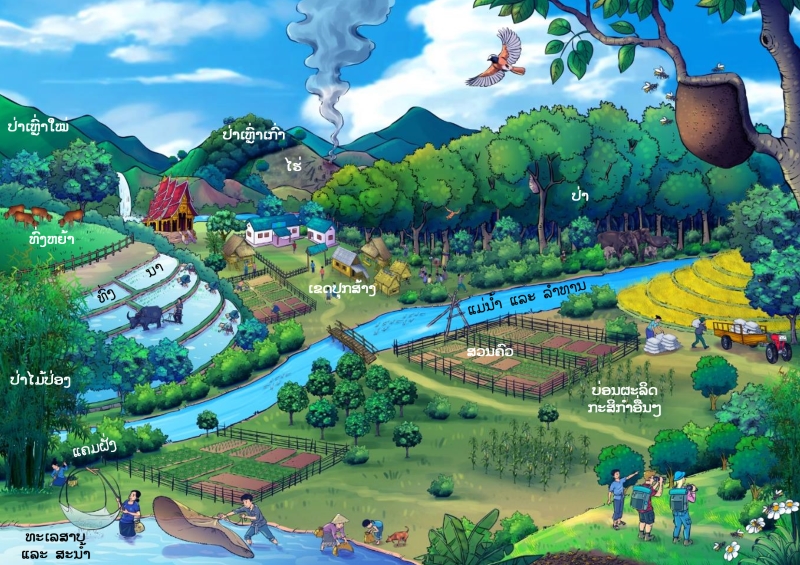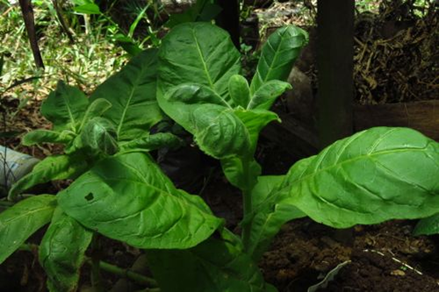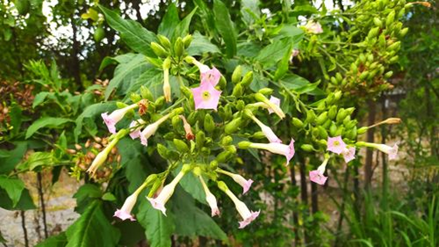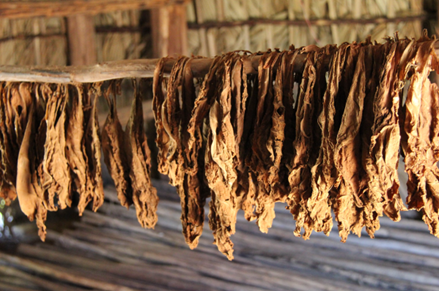ເລກລຳດັບທີ: 2599
ລະດັບການຮວບຮວມຂໍ້ມູນ: ຂໍ້ມູນພື້ນຖານ
ປັບປູງຄັ້ງລ່າສຸດ: 2024-10-11
ຢາສູບ
Tobacco
Nicotiana tabacum L.
ພືດ
ພືດລົ້ມລຸກ
ຜັກ ແລະ ພືດລົ້ມລຸກ
×
ຊື່ທ້ອງຖີ່ນ:
ຢາເສັ້ນ ( Cultivated tobacco and Virginia tobacco)
ຊື່ພ້ອງ
:
Nicotiana chinensis Fisch. ex Lehm.
Nicotiana fruticosa Moc. & Sessé ex Dunal
Nicotiana latissima Mill.
Nicotiana mexicana Schltdl.
Nicotiana mexicana var. rubriflora Dunal
Nicotiana pilosa Dunal
Nicotiana tabaca St.-Lag.
Nicotiana fruticosa Moc. & Sessé ex Dunal
Nicotiana latissima Mill.
Nicotiana mexicana Schltdl.
Nicotiana mexicana var. rubriflora Dunal
Nicotiana pilosa Dunal
Nicotiana tabaca St.-Lag.
ຊື່ສະກຸນ:
Solanaceae
ຊະນິດໃກ້ຄຽງ:
ບັນຍາຍລັກສະນະທາງພືດສາດ:
ຢາສູບເປັນພືດລົ້ມລຸກທີ່ມີອາຍຸສັ້ນ ຫຼື ຫຼາຍປີ ສາມາດເຕີບໂຕໄດ້ສູງເຖິ່ງ 2.5 ແມັດ. ໃບຮູໄຂ່ປົນຮູບຫອກ (ຮູບໄຂ່ - ຮູບຫອກ) ຫຼື ຮູບໄຂ່, ຂອບລຽບ, ຍາວຕັ້ງແຕ່ 5 ຫາ 50 ຊມ. ແລະ ກວ້າງ 5 ຫາ 25 ຊມ. ດອກຍ່ອຍເປັນຮູບຈວຍ, ໂຄນກີບເປັນສີເຫຼືອງ, ດອກສີບົວອອ່ນ ຫຼື ບາງຄັ້ງເປັນສີແດງ, ສີເຫຼືອງ ຫຼື ສີຂຽວ. ຊໍ່ດອກແບບກະຈະ (thyrsoid panicles). ໝາກເປັນແບບແຄັບຊູ ແຍກອອກເປັນສອງສ່ວນ ແຕ່ລະສ່ວນມີແກ່ນຮູບໄຂ່ ຫຼື ຮູບກົມຂະໜາດນ້ອຍປະມານ 2,000 ຫາ 5,000 ແກ່ນ.
ແຫຼ່ງທີ່ມາ: [4]
ແຫຼ່ງທີ່ມາ: [4]
ນິເວດວິທະຍາ
ເຂດກະຈາຍພັນທົ່ວໂລກ:
Antarctic, Argentina Northeast, Bolivia, Mexico, Siberia, America, Suramérica.
ເຂດກະຈາຍພັນໃນລາວ
:
ເຂດພູສູງພາກເໜືອຂອງລາວ
ລຽບແມ່ນ້ຳຂອງພາກເໜືອ
ເຂດພູສູງສາຍພູຫຼວງ ແລະ ເຂດພູພຽງແຂວງຊຽງຂວາງ
ທົ່ງພຽງວຽງຈັນ
ເຂດສາຍພູຫຼວງພາກເໜືອ
ເຂດສາຍພູຫຼວງພາກກາງ
ເຂດສາຍພູຫຼວງຕອນລຸ່ມ
ສາຍພູຫຼວງພາກໃຕ້
ເຂດລຽບແມ່ນ້ຳຂອງພາກໃຕ້
ພູພຽງບໍລິເວນ
ລຽບແມ່ນ້ຳຂອງພາກເໜືອ
ເຂດພູສູງສາຍພູຫຼວງ ແລະ ເຂດພູພຽງແຂວງຊຽງຂວາງ
ທົ່ງພຽງວຽງຈັນ
ເຂດສາຍພູຫຼວງພາກເໜືອ
ເຂດສາຍພູຫຼວງພາກກາງ
ເຂດສາຍພູຫຼວງຕອນລຸ່ມ
ສາຍພູຫຼວງພາກໃຕ້
ເຂດລຽບແມ່ນ້ຳຂອງພາກໃຕ້
ພູພຽງບໍລິເວນ

ເຂດກະຈາຍພັນຕາມພູມສັນຖານ
:
ທົ່ງນາ
ເຂດຜະລິດພືດຜົນເນີນສູງ
ເຂດກະສິກຳອື່ນໆ
ສວນຄົວ
ເຂດຜະລິດພືດຜົນເນີນສູງ
ເຂດກະສິກຳອື່ນໆ
ສວນຄົວ

ສະເພາະຖິ່ນໃນລາວ:
ຕ່າງຖິ່ນ
ຮຸກຮານ
:
ບໍ່ຮຸກຮານ
ສະຖານະພາບການອະນູຮັກ IUCN
:
ບໍ່ມີຄວາມສ່ຽງ
ສະຖານະພາບການອະນຸຮັກແຫ່ງຊາດລາວ
:
ບໍ່ຖືກລະບຸໃນບັນຊີປະເພດໃດ
ການນຳໃຊ້
ປະເພດການນຳໃຊ້:
ພືດເປັນຢາ
ກິດຈະກຳການກະເສດ
ວັດທະນະທຳ ແລະ ຮີດຄອງ
ບໍ່ແນະນຳໃຫ້ໃຊ້
ກິດຈະກຳການກະເສດ
ວັດທະນະທຳ ແລະ ຮີດຄອງ
ບໍ່ແນະນຳໃຫ້ໃຊ້
ບັນຍາຍການນຳໃຊ້:
ຢາ: ໃບຢາສູບຕົ້ມແລ້ວນໍາມາປິດໃສ່ບໍລິເວນຫົວຝີ ເພື່ອຊ່ວຍຂັບຫົວຝີອອກ, ໃບສາມາດນຳມາສູບເພື່ອຊ່ວຍຮັກສາແຂ້ວ ແລະ ປ້ອງກັນແຂ້ວຜຸ, ນຳໃບຢາສູບແຫ້ງທີ່ບົດເປັນຜົງມາປະສົມກັບນ້ຳ ແລ້ວນຳໄປສະຜົມ ໂດຍຈະໝັກໄວ້ປະມານ 15 ຫາ 20 ນາທີ ເພື່ອຊ່ວຍກໍາຈັດເຫົາ. ການປະສົມໃບຢາສູບກັບເກືອໃຊ້ທາບໍລິເວນຂາຈະຊ່ວຍປ້ອງກັນປີງເກາະໄດ້. [7]
ໃຊ້ໃນຟາມ: ການປະສົມໃບຢາສູບກັບນ້ຳສີດພົ່ນ ເປັນວິທີທີ່ດີໃນການກຳຈັດແມງໄມ້ສັດຕູພືດ ແລະ ເພ້ຍອ່ອນໃນພືດຜັກ [15].
ວັດທະນະທຳ ແລະ ສາສະໜາ: ໃນລາວໃບຢາສູບຖືກນໍາມາໃຊ້ໃນພິທີກໍາຕ່າງໆ ເຊັ່ນ: ພິທີບາຍສີສູ່ຂວັນ, ພິທີຂໍແຕ່ງງານຂອງເຈົ້າບ່າວເຈົ້າສາວ, ນອກຈາກນີ້ຍັງໃຊ້ໃນພິທີຕ່າງໆ ອີກດ້ວຍ [8].
ບໍ່ແນະນໍາໃຫ້ໃຊ້: ພວdເຮົາໃນນາມພາເຂົ້າລາວບໍ່ແນະນຳໃຫ້ໃຊ້ພືດຊະນິດນີ້ໃນການສູບ ເນື່ອງຈາກການສູບຢາເປັນສາເຫດຂອງການເກີດມະເຮັງປອດປະມານ 90% [9], [10]. ນອກຈາກນີ້ຍັງເປັນສາເຫດຫຼັກຂອງມະເຮັງໃນຊ່ອງປາກ, ຄໍ, ຫຼອດອາຫານ, ຄໍຫອຍ, ກ່ອງສຽງ, ລີ້ນ, ຮິມປາກ ແລະ ຕ່ອມນ້ຳລາຍ [10]. ການສູບຢາເປັນສາເຫດຂອງພະຍາດປອດອຸດຕັນຊ້ຳເຮື້ອ (COPD) ເຊັ່ນ: ພະຍາດຖົງລົມໃຄ່ 70% (ຫຼືຫຼາຍກ່ວານັ້ນ) ເຊິ່ງເປັນພະຍາດທີ່ເຮັດໃຫ້ມີອາການຫາຍໃຈລຳບາກຂື້ນໆ. ຜູ້ທີ່ສູບຢາຈະມີຄາມສ່ຽງຕໍ່ການເກີດໂຣກຫົົວໃຈ ເຊິ່ງນຳໄປສູ່ຫົວໃຈວາຍກ່ວາ ຄົນທີ່ບໍ່ສູບຢາ 2 ຫາ 4 ເທົ່າ [10] ແລະ ເຮັດໃຫ້ເກີດພະຍາດກ່ຽວກັບຫຼອດເລືອດ. [9], [10].
ໝາຍເຫດ: ໃນນາມໂຄງການພາເຂົ້າລາວ ພວກເຮົາຂໍສະແດງຄວາມເປັນຫ່ວງມາຍັງປະຊາຊົນ ໂດຍຄຳນຶງເຖິ່ງສຸຂະພາບ ແລະ ສິ່ງແວດລ້ອມ, ພວກເຮົາບໍ່ແນະນຳໃຫ້ສູບຢາ ເພື່ອສຸຂະພາບ ແລະ ສິ່ງແວດລ້ອມທີ່ດີຂອງຕົວທ່ານເອງ.
ໃຊ້ໃນຟາມ: ການປະສົມໃບຢາສູບກັບນ້ຳສີດພົ່ນ ເປັນວິທີທີ່ດີໃນການກຳຈັດແມງໄມ້ສັດຕູພືດ ແລະ ເພ້ຍອ່ອນໃນພືດຜັກ [15].
ວັດທະນະທຳ ແລະ ສາສະໜາ: ໃນລາວໃບຢາສູບຖືກນໍາມາໃຊ້ໃນພິທີກໍາຕ່າງໆ ເຊັ່ນ: ພິທີບາຍສີສູ່ຂວັນ, ພິທີຂໍແຕ່ງງານຂອງເຈົ້າບ່າວເຈົ້າສາວ, ນອກຈາກນີ້ຍັງໃຊ້ໃນພິທີຕ່າງໆ ອີກດ້ວຍ [8].
ບໍ່ແນະນໍາໃຫ້ໃຊ້: ພວdເຮົາໃນນາມພາເຂົ້າລາວບໍ່ແນະນຳໃຫ້ໃຊ້ພືດຊະນິດນີ້ໃນການສູບ ເນື່ອງຈາກການສູບຢາເປັນສາເຫດຂອງການເກີດມະເຮັງປອດປະມານ 90% [9], [10]. ນອກຈາກນີ້ຍັງເປັນສາເຫດຫຼັກຂອງມະເຮັງໃນຊ່ອງປາກ, ຄໍ, ຫຼອດອາຫານ, ຄໍຫອຍ, ກ່ອງສຽງ, ລີ້ນ, ຮິມປາກ ແລະ ຕ່ອມນ້ຳລາຍ [10]. ການສູບຢາເປັນສາເຫດຂອງພະຍາດປອດອຸດຕັນຊ້ຳເຮື້ອ (COPD) ເຊັ່ນ: ພະຍາດຖົງລົມໃຄ່ 70% (ຫຼືຫຼາຍກ່ວານັ້ນ) ເຊິ່ງເປັນພະຍາດທີ່ເຮັດໃຫ້ມີອາການຫາຍໃຈລຳບາກຂື້ນໆ. ຜູ້ທີ່ສູບຢາຈະມີຄາມສ່ຽງຕໍ່ການເກີດໂຣກຫົົວໃຈ ເຊິ່ງນຳໄປສູ່ຫົວໃຈວາຍກ່ວາ ຄົນທີ່ບໍ່ສູບຢາ 2 ຫາ 4 ເທົ່າ [10] ແລະ ເຮັດໃຫ້ເກີດພະຍາດກ່ຽວກັບຫຼອດເລືອດ. [9], [10].
ໝາຍເຫດ: ໃນນາມໂຄງການພາເຂົ້າລາວ ພວກເຮົາຂໍສະແດງຄວາມເປັນຫ່ວງມາຍັງປະຊາຊົນ ໂດຍຄຳນຶງເຖິ່ງສຸຂະພາບ ແລະ ສິ່ງແວດລ້ອມ, ພວກເຮົາບໍ່ແນະນຳໃຫ້ສູບຢາ ເພື່ອສຸຂະພາບ ແລະ ສິ່ງແວດລ້ອມທີ່ດີຂອງຕົວທ່ານເອງ.
ການປູກ ການລ້ຽງ:
ຊະນິດປູກ
ລະດູການເກັບກູ້:
ມັງກອນ
ເມສາ
ພຶກສະພາ
ມິຖຸນາ
ກໍລະກົດ
ກັນຍາ
ຕຸລາ
ພະຈິກ
ທັນວາ
ເມສາ
ພຶກສະພາ
ມິຖຸນາ
ກໍລະກົດ
ກັນຍາ
ຕຸລາ
ພະຈິກ
ທັນວາ
ການຕະຫຼາດ ແລະ ຕ່ອງໂສ້ມູນຄ່າ:
ມີບໍລິສັດຮັບຊື້ ແລະ ແປຮູບຢາສູບເພື່ອຈຳນ່າຍ ທັງໃນປະເທດ ແລະ ຕ່າງປະເທດ. ປັດຈຸບັນພື້ນທີ່ການປູກຢາສູບໃນລາວ ກຳລັງຂະຫຍາຍຕົວ ແລະ ສົ່ງໃຫ້ໂຮງງານ ເພື່ອສ້າງລາຍໄດ້ໃຫ້ກັບຄອບຄົວ.
ການຄຸ້ມຄອງຈັດການ
ສະພາບໂດຍລວມ:
ອຸນຫະພູມ: ອຸນຫະພູມທີ່ເໝາະສົມທີ່ສຸດໃນການປູກຢາສູບຄື ລະຫວ່າງ 21 ຫາ 26 ອົງສາ, ອຸນຫະພູມໃນກາງວັນບໍ່ຄວນເກີນ 29 ຫາ 32 ອົງສາ ແລະອຸນຫະພູມກາງຄືບໍ່ຄວນເກີນ 18 ຫາ 21 ອົງສາ ຖ້າບໍ່ດັງນັ້ນຢາສູບຈະເຕີບໂຕຊ້າ [15]. ຢາສູບຕ້ອງການໄລຍະເວລາໃນການເຕີບໂຕ ໂດຍບໍ່ມີນ້ຳຄ້າງແຂງ 90 ຫາ 120 ວັນ. ລດູແລ້ງມີຄວາມສຳຄັນຕໍ່ກັບການສຸກ ແລະ ການເກັບກ່ຽວໃບຢາສູບ. [12]
ປະລິມານນ້ຳຝົນ: ປະລິມານນ້ຳຝົນທີ່ເໝາະສົມຕໍ່ການຈະເລີນເຕີບໂຕຂອງຢາສູບຄື 25 ຫາ 1,270 ມມ. ຕໍ່ລະດູການປູກ, ຝົນຝອຍທີ່ຕົກຢ່າງຕໍ່ເນື່ອງຈະດີຕໍ່ການຈະເລີນເຕີບໂຕຂອງຢາສູບ ຫຼາຍກ່ວາຝົນຕົກແຮງ ແຕ່ຕົກເວລາສັ້ນ [15] ຝົນທີ່ຕົກຫຼາຍເກີນໄປອາດຈະເຮັດໃຫ້ໃບຢາສູບເສຍຫາຍ ແລະ ໃບຢາສູບທີ່ຕາກແດດ ຕ້ອງມີສະພາບອາກາດທີ່ຂ້ອນຂ້າງແຫ້ງ ເພື່ອໃຫ້ມີກິ່ນຫອມເຕັມທີ. [12]
ສະພາບດິນປູກ: ຢາສູບເຕີບໂຕໄດ້ດີທີ່ສຸດໃນສະພາບດິນທີ່ມີການຖ່າຍເທອາກາດ ແລະ ນ້ຳໄດ້ດີ ໂດຍມີຄ່າ pH ຢູ່ລະຫວ່າງ 5 ຫາ 6, 5. ເຊິ່ງພືດແຕ່ລະປະເພດຕ້ອງການດິນທີ່ມີເນື້ອສຳພັດສະເພາະ ເຊັ່ນ: ດິນຊາຍສຳຫຼັບຢາສູບທີ່ບົ່ມດ້ວຍເຕົາເຜົາ ແລະ ດິນຜຸຜຸຍປົນຊາຍ ຫຼື ດິນໜຽວສຳຫຼັບຢາສູບສີເຂັ້ມທີ່ບົ່ມຕາມອາກາດ. [12].
ການຄັດເລືອກສາຍພັນ:
ພັນໃບກ້ວາງ: ເປັນສາຍພັນດັງເດີມທີ່ມີລໍາຕົ້ນໃຫຍ່ ແລະ ໜາ, ມີສານນີໂຄຕິນຫຼາຍກ່ວາ ແລະ ບໍ່ນິຍົມປູກ ເນື່ອງຈາກບໍ່ເປັນທີ່ນິຍົມໃນໂຮງງານ.
ປະເພດໃບແຄບ: ເປັນປະເພດຢາສູບທີ່ນິຍົມປູກຫຼາຍທີ່ສຸດ ເພື່ອສົ່ງໄປຍັງໂຮງານແປຮູບ.
ຢາສູບປ່າ: ເປັນຢາສູບປະເພດໜຶ່ງທີ່ພົບໄດ້ທົ່ວໄປໃນທໍາມະຊາດ ແຕ່ບໍ່ນໍາມາໃຊ້ສູບ ໃບມີລັກສະນະຮຽວຍາວ, ຂອບເປັນແສກ ແລະ ກ້ານໃບເປັນຫຼ່ຽມເລັກນ້ອຍ
ແຫຼ່ງທີ່ມາ: [15]
ການກຽມພື້ນທີ່:
ຕຽມດິນໃຫ້ຄືກັບໜານຜັກ ກ້ວາງ 1 ແມັດ, ຍາວພໍປະມານ ດິນຕ້ອງລະອຽດເພາະແກ່ນຢາສູບມີຂະໜາດນ້ອຍ, ຖ້າດິນດູດຊັບນໍ້າໄດ້ຍາກຄວນໂຮຍຂີ້ເລືອຍ ຫຼື ຊາຍ ປົກໄວ້ເພື່ອປ້ອງກັນບໍ່ໃຫ້ແກ່ນໄຫຼ່ເມື່ອຫົດນໍ້າ. [15]
ເທັກນິກການປູກ:
ຢາສູບປູກໃນໜານກ້າແກ່ນກ່ອນ ແລະ ຍ້າຍປູກເມື່ອຕົ້ນກ້າສູງປະມານ 15 ຊມ. ຫຼັງຈາກຫວ່ານແກ່ນໄດ້ 40 ຫາ 60 ວັນ. ໃນອາທິດທຳອິດຄວນຄຸມໜານປູກ ເພື່ອປ້ອງກັນຕົ້ນກ້າຈາກສະພາບອາກາດທີ່ບໍ່ເໝາະສົມ. [12]
ຫຼັງຈາກນັ້ນໃຫ້ຍ້າຍກ້າປູກ ໂດຍເວັ້ນໄລ່ຍະຫ່າງລະຫວ່າງຕົ້ນ 1.2 ຫາ 0.9 ແມັດ ແລະ 0.9 ຫາ 0.6 ແມັດ ຂື້ນຢູ່ກັບສາຍພັນ, ແນະນຳໃຫ້ປູກພືດໝູນວຽນຫຼັງຈາກປູກໄດ້ 1 ຫາ 2 ລະດູການ ໂດຍໃຊ້ພືດທີ່ບໍ່ໄວຕໍ່ພະຍາດ ເຊັ່ນ: ຫຍ້າ, ເຂົ້າຝ້າງ ແລະ ສາລີ ເພື່ອປ້ອງກັນບັນຫາຕ່າງໆ ເຊັ່ນ: ໜອນໄຍຜັກ. [12]
ການເບິ່ງແຍງ ແລະ ບຳລຸງຮັກສາ:
ການປູກ ແລະ ການຄູນດິນ: ຫຼັງຈາກປູກແລ້ວ ທີ່ສຳຄັນຕ້ອງເບິ່ງແຍງສຸຂະພາບຂອງຕົ້ນຢາສູບ ຫາພົບວ່າມີຕົ້ນຕາຍ ຄວນປູກໃໝ່ທັນທີ່ພາຍໃນໜຶ່ງອາທິດ ຫຼັງຈາກປູກຄັ້ງທຳອິດ. ສຳຫຼັບການຄູນດິນ ແນະນຳໃຫ້ຄູນດິນທັນທີ່ເມື່ອດິນອັດແໜ້ນ ເພື່ອປ້ອງກັ່ນບໍ່ໃຫ້ນ້ຳຂັງ ສາມາດເຮັດໄດ້ທຸກສອງອາທິດ ຫຼື ຕາມຄວາມຈຳເປັນ. [15]
ການໃສ່ປຸ໋ຍ: ຢາສູບມີຄວາມຕ້ອງການສານອາຫານສະເພາະ ໂດຍສະເພາະທາດແມັກນີຊ້ຽມອັອກໄຊນ໌ (MgO). ໃນການຈະເລີນເຕີບໂຕ ແລະ ຜົນລັບທີ່ດີຈຳເປັນຕ້ອງສ່ປຸ໋ຍເຄມີ, ສູດທີ່ແນະນຳ 04-16-24+4 (MgO). ໃນອັດຕາສ່ວນ 100 ຫາ 150 ກິໂລຕໍ່ໄຣ່ ຫຼື ອີກວິທີ່ໜຶ່ງຄືໃຊ່ປຸ໋ຍສູດ 06-18-24+4 (MgO) ໂດຍແບ່ງໃສ່ 2 ຄັ້ງ ຄື: ຄັ້ງທຳອິດໃສ່ ຫຼັງປູກ 7 ຫາ 10 ວັນ ແລະ ຄັ້ງທີ່ສອງແມ່ນໃສ່ 25-30 ວັນຫຼັງປູກ. [15]
ການຕັດແຕ່ງຍອດ: ແມ່ນການຕັດຍອດ, ກິ່ງ, ດອກ ແລະ ໃບນ້ອຍທີ່ບໍ່ສົມບູນ 4-7 ໃບຈາກຕົ້ນຢາສູບ, ວິທີການນີ້ຈະເຮັດໃຫ້ໃບທີ່ຍັງໄດ້ຮັບນ້ຳ ແລະ ສານອາຫານພຽງພໍ ຈິ່ງເຮັດໃຫ້ມີຄຸນນະພາບດີຂື້ນ. [15]
ການຫົດນ້ຳ: ຫາກຝົນຕົກພຽງພໍກໍບໍ່ຈຳເປັນຕ້ອງຫົດນ້ຳເພີ່ມເຕີມ ຢ່າງໃດກໍ່ຕາມໃນລະດູແລ້ງ ຫຼື ເມື່ອຝົນບໍ່ຕົກ ການຫົດນ້ຳຈຶ່ງບໍ່ຈຳເປັນ. ສຳຫຼັບຢາສູບທີ່ປູກໃໝ່ຄວນຫົດນ້ຳວັນລະ 1 ຫຼື 2 ຄັ້ງໃນອາທິດທຳອິດ ເພື່ອໃຫ້ແນ່ໃຈວ່າມີຄວາມຊຸ່ມພຽງພໍສຳຫຼັບການຈະເລີນເຕີບໂຕ ຫຼັງຈາກນັ້ນຄວນລົດຄວາມຖີ່ໃນການໃຫ້ນ້ຳລົງ ໂດຍປ່ຽນເປັນໜຶ່ງຄັ້ງຕໍ່ອາທິດ ເພື່ອຮັກສາລະດັບຄວາມຊຸ່ມໃນດິນໃຫ້ເໝາະສົມ. [15]
ການປົກປ້ອງ ແລະ ການກຳຈັດສັດຕູພືດ:
ພະຍາດຮາກເນົ່າ (ໂຄນເນົ່າ): [13]
ສາເຫດ: ໂຣກເຊື້ອຣາທີ່ເກີດຈາກເຊື້ອ Pythium ຫຼື Rhizoctonia.
ອາການ: ຕົ້ນກ້າຈະນ້ອຍ ແລະ ລົ້ມເປັນຈຸດໆ, ເຮັດໃຫ້ລຳຕົ້ນບໍ່ຮຽວ. ຕົ້ນກ້ານ້ອຍຈະເປັນສີນ້ຳຕານອ່ອນ ລຳຕົ້ນຈະນ້ອຍ ແລະ ໃນທີ່ສຸດຕົ້ນກ້າກໍ່ຈະລົ້ມລົງ ແລະ ຕາຍ ເຮັດໃຫ້ເກີດໂຣກເນົ່າເປືອຍ.
ການປ້ອງກັນ ແລະ ກຳຈັດ: ໃນຊ່ວງລະດູຮ້ອນ ສາມາດກຳຈັດເຊື້ອຣາໄດ້ໂດຍການໄຖ່ຟື້ນດິນໃຫ້ເລິກ (ເພື່ອຄາຍດິນ). ອີກວິທີ່ໜຶ່ງຄື ກຽມໜານກ້າແກ່ນທີ່ມີຄວາມສູງ 15 ຊມ.ພ້ອມຮ່ອງລະບາຍນ້ຳ ຫຼື ຫຼີກລຽງການປູກຕົ້ນກ້າແໜ້ນເກີນໄປ.
ພະຍາດແອນແທຣກໂນດ [13]:
ສາເຫດ: ເປັນພະຍາດທີ່ເກີດຈາກເຊື້ອຣາ Colletotrichum tabacum.
ອາການ: ມີຈຸດຂະໜາດນ້ອຍສີຂຽວອອ່ນ ຫຼື ສີຂາວໃນໃບອອ່ນ, ແລະ ຈະຂະຫຍາຍກ້ວາງອອກເມື່ອອາກາດຊື້ນ, ເຮັດໃຫ້ເກີດເປັນຈຸດກົມໆ ທີ່ມີເສັ້ນຜ່າສູນກາງປະມານ 3 ມມ. ແລະ ຈະຄ່ອຍໆແຫ້ງຄ້າຍກະດ້າດ ຜິວບາງ ແລະ ເປັນສີເທົາອົມຂາວ, ຂອບສີນ້ຳຕານ. ໃບທີ່ໄດ້ຮັບເຊື້ອຈະຫ້ຽວຍົ້ນ ແລະ ບິດບ້ຽວ, ໃນກໍລະນີມີການລະບາດຮຸນແຮງຈະເປັນຮອຍສີດຳ ຫຼື ສີນ້ຳຕານຂື້ນບໍລິເວນເສັ້ນກາງໃບ ແລະ ກ້ານໃບ, ບົນລຳຕົ້ນຈະພົບຮອຍສີນ້ຳຕານຍາວ ຫຼື ຮູບໄຂ່ ເປັນຈຳນວນຫຼາຍ, ເຮັດໃຫ້ຕົ້ນກ້າບໍ່ເໝາະສົມສຳຫຼັບການຍ້າຍປູກ.
ການລະບາດ: ມັກພົບໃນພື້ນທີ່ທີ່ມີຄວາມຊຸ່ມສູງ ແລະ ແສງແດດໜ້ອຍ.
ການຈັດການ ແລະ ປ້ອງກັນ: ຄວນກຽມເບ້ຍໃຫ້ຖືກຕ້ອງ, ບໍ່ຄວນໃຊ້ແກ່ນພັນທີ່ຕິດເຊື້ອມາກ່ອນ, ປະສົມສານໄຊຍາໄນລົງໃນພື້ນໃນອັດຕາ 110 ກຼາມ/10 ຕາແມັດ ເລິກ 70 ຊມ.
ພະຍາດຣາຂາວ [13]:
ສາເຫດ: ເປັນພະຍາດທີ່ເກີດຈາກດິນທີ່ເຊື້ອຣາ Oomycete Phytophthora parasitica var. nicotianae, ເປັນພື້ນທີ່ມີອາກາດຊຸ່ມສູງເປັນເວລາດົນ ແລະ ມີອຸ່ນຫະພູມຕໍ່າກ່ວາ 22 ອັງສາ.
ອາການ: ຮາກເປັນສີດຳ ແລະ ໃບມີແຜສີດຳ.
ການປ້ອງກັນ: ວິທີ່ປ້ອງກັ່ນແມ່ນຄືກັບການປ້ອງກັນພະຍາດດຮາກເນົ່າກໍ່ສາມາດໃຊ້ໄດ້ຄືກັນ.
ການເກັບກ່ຽວ (ເວລາທີ່ເໝາສົມ, ເທັກນິກ, ການຈັດການ ແລະ ການເກັບຮັກສາຫຼັງການເກັບກ່ຽວ)
ຢາສູບຈະສາມາດເກັບກ່ຽວໄດ້ພາຍໃນ 70 ຫາ 130 ວັນ ຫຼັງຈາກຍ້າຍກ້າປູກ, ໂດຍການເກັບມີຢູ່ 2 ວິທີດັງຕໍ່ໄປນີ້: (1). ຕັດທັງຕົ້ນ ແລ້ວຜ່າກາງຕົ້ນ ຈາກນັ້ນນຳໄປແຂວນໄວ້ເທິງແທງຢາສູບ ຫຼື ໄມ້ຮາວຕາກ (ໄມ້ບາງໆ) ແລະ (2). ເກັບໃບຢາສູບເທື່ອລະໃບ ເລືອກໃບທີ່ຂະຍາຍຕົວເຕັມທີ [14].
ການບົ່ມ: ແມ່ນຂະບວນການເຮັດໃຫ້ແຫ້ງ ແລະ ມີອາຍຸການນຳໃຊ້ດົນຂື້ນ, ເຮັດໃຫ້ມີຣົດຊາດ, ກິ່ນ ແລະ ຄຸນນະພາບໂດຍລວມ. ການບົ່ມຢາສູບປະກອບດ້ວຍ 4 ຂັ້ນຕອນສຳຄັນ ໄດ້ແກ່ ການເຮັດໃຫ້ຫ້ຽວ, :ຫຼືອງ, ສີ ແລະ ການເຮັດໃຫ້ແຫ້ງ. ເຊິ່ງຈະຊ່ວຍເພີ່ທຄຸນສົມບັດຂອງໃບຢາສູບ, ວິທີການບົ່ມທີ່ພົບຫຼາຍທີ່ສຸດໄດ້ແກ່ການບົ່ມດ້ວຍອາກາດ, ໄຟ ແລະ ປອງຄວັນ, ໂດຍບາງຄັ້ງກໍໃສ້ການບົ່ມດ້ວຍແສງແດດ
ການບົ່ມດ້ວຍອາກາດ: ຈະບົ່ມຢາສູບດ້ວຍໃຊ້ອຸ່ນຫະພູມຫ້ອງ ໂດຍໃຊ້ຄວາມຮ້ອນເພີ່ມເຕີມຈາກການເຜົາຖ່ານ, ໄມ້ ຫຼື ກາສປີໂຕເລີ້ຍມຫາກຈຳເປັນ, ວິທີນີ້ໃຊ້ເວລາ 1 ຫາ 2 ເດືອນ
ການອົບດ້ວຍໄຟ: ຄ້າຍກັນກັບການອົບດ້ວຍອາກາດ ແຕ່ໃຊ້ໄຟຈາກໄມ້ແບບເປີດໃນໂຮງອົບ, ຫຼັງຈາກນັ້ນບໍ່ກີ່ມື້ ຄວັນຈະເຮັດໃຫ້ຢາສູບມີກິ່ນສະເພາະຕົວຂະບວນການນີ້ອາດໃຊ້ເວລາ 3 ຫາ 10 ອາທິດ ຂື້ນກັບຄວາມຕ້ອງການ.
ການອົບໃບຢາສູບດ້ວຍຄວັນ: ເປັນການອົບໃບຢາສູບໂດຍໃຊ້ຄວາມຮ້ອນທີ່ຕ້ອງໄດ້ຄວບຄຸມຢ່າງລະມັດລະວັງຈາກຄວິນ (ທໍ່) ທີ່ເຊື່ອຕໍ່ກັບເຕົາເຜົາ, ວິທີນີ້ໃຊ້ເວລາ 4 ຫາ 8 ວັນ ໂດຍຕ້ອງຕິດຕາມການປ່ຽນແປງທາງເຄມີ ແລະ ກາຍະພາບຂອງໃບຢາສູບຢ່າງໃກ້ຊິດ.
ການອົບດ້ວຍແສງແດດ: ໃຊ້ຫຼັກໃນໃຢາສູບທີ່ມີກິ່ນຫອມ ທີ່ໜ້ອຍກ່ວາໃບຢາສູບປະເພດທີ່ອົບດ້ວຍອາກາດ.
ແຫຼ່ງທີ່ມາ: [14]
ອຸນຫະພູມ: ອຸນຫະພູມທີ່ເໝາະສົມທີ່ສຸດໃນການປູກຢາສູບຄື ລະຫວ່າງ 21 ຫາ 26 ອົງສາ, ອຸນຫະພູມໃນກາງວັນບໍ່ຄວນເກີນ 29 ຫາ 32 ອົງສາ ແລະອຸນຫະພູມກາງຄືບໍ່ຄວນເກີນ 18 ຫາ 21 ອົງສາ ຖ້າບໍ່ດັງນັ້ນຢາສູບຈະເຕີບໂຕຊ້າ [15]. ຢາສູບຕ້ອງການໄລຍະເວລາໃນການເຕີບໂຕ ໂດຍບໍ່ມີນ້ຳຄ້າງແຂງ 90 ຫາ 120 ວັນ. ລດູແລ້ງມີຄວາມສຳຄັນຕໍ່ກັບການສຸກ ແລະ ການເກັບກ່ຽວໃບຢາສູບ. [12]
ປະລິມານນ້ຳຝົນ: ປະລິມານນ້ຳຝົນທີ່ເໝາະສົມຕໍ່ການຈະເລີນເຕີບໂຕຂອງຢາສູບຄື 25 ຫາ 1,270 ມມ. ຕໍ່ລະດູການປູກ, ຝົນຝອຍທີ່ຕົກຢ່າງຕໍ່ເນື່ອງຈະດີຕໍ່ການຈະເລີນເຕີບໂຕຂອງຢາສູບ ຫຼາຍກ່ວາຝົນຕົກແຮງ ແຕ່ຕົກເວລາສັ້ນ [15] ຝົນທີ່ຕົກຫຼາຍເກີນໄປອາດຈະເຮັດໃຫ້ໃບຢາສູບເສຍຫາຍ ແລະ ໃບຢາສູບທີ່ຕາກແດດ ຕ້ອງມີສະພາບອາກາດທີ່ຂ້ອນຂ້າງແຫ້ງ ເພື່ອໃຫ້ມີກິ່ນຫອມເຕັມທີ. [12]
ສະພາບດິນປູກ: ຢາສູບເຕີບໂຕໄດ້ດີທີ່ສຸດໃນສະພາບດິນທີ່ມີການຖ່າຍເທອາກາດ ແລະ ນ້ຳໄດ້ດີ ໂດຍມີຄ່າ pH ຢູ່ລະຫວ່າງ 5 ຫາ 6, 5. ເຊິ່ງພືດແຕ່ລະປະເພດຕ້ອງການດິນທີ່ມີເນື້ອສຳພັດສະເພາະ ເຊັ່ນ: ດິນຊາຍສຳຫຼັບຢາສູບທີ່ບົ່ມດ້ວຍເຕົາເຜົາ ແລະ ດິນຜຸຜຸຍປົນຊາຍ ຫຼື ດິນໜຽວສຳຫຼັບຢາສູບສີເຂັ້ມທີ່ບົ່ມຕາມອາກາດ. [12].
ການຄັດເລືອກສາຍພັນ:
ພັນໃບກ້ວາງ: ເປັນສາຍພັນດັງເດີມທີ່ມີລໍາຕົ້ນໃຫຍ່ ແລະ ໜາ, ມີສານນີໂຄຕິນຫຼາຍກ່ວາ ແລະ ບໍ່ນິຍົມປູກ ເນື່ອງຈາກບໍ່ເປັນທີ່ນິຍົມໃນໂຮງງານ.
ປະເພດໃບແຄບ: ເປັນປະເພດຢາສູບທີ່ນິຍົມປູກຫຼາຍທີ່ສຸດ ເພື່ອສົ່ງໄປຍັງໂຮງານແປຮູບ.
ຢາສູບປ່າ: ເປັນຢາສູບປະເພດໜຶ່ງທີ່ພົບໄດ້ທົ່ວໄປໃນທໍາມະຊາດ ແຕ່ບໍ່ນໍາມາໃຊ້ສູບ ໃບມີລັກສະນະຮຽວຍາວ, ຂອບເປັນແສກ ແລະ ກ້ານໃບເປັນຫຼ່ຽມເລັກນ້ອຍ
ແຫຼ່ງທີ່ມາ: [15]
ການກຽມພື້ນທີ່:
ຕຽມດິນໃຫ້ຄືກັບໜານຜັກ ກ້ວາງ 1 ແມັດ, ຍາວພໍປະມານ ດິນຕ້ອງລະອຽດເພາະແກ່ນຢາສູບມີຂະໜາດນ້ອຍ, ຖ້າດິນດູດຊັບນໍ້າໄດ້ຍາກຄວນໂຮຍຂີ້ເລືອຍ ຫຼື ຊາຍ ປົກໄວ້ເພື່ອປ້ອງກັນບໍ່ໃຫ້ແກ່ນໄຫຼ່ເມື່ອຫົດນໍ້າ. [15]
ເທັກນິກການປູກ:
ຢາສູບປູກໃນໜານກ້າແກ່ນກ່ອນ ແລະ ຍ້າຍປູກເມື່ອຕົ້ນກ້າສູງປະມານ 15 ຊມ. ຫຼັງຈາກຫວ່ານແກ່ນໄດ້ 40 ຫາ 60 ວັນ. ໃນອາທິດທຳອິດຄວນຄຸມໜານປູກ ເພື່ອປ້ອງກັນຕົ້ນກ້າຈາກສະພາບອາກາດທີ່ບໍ່ເໝາະສົມ. [12]
ຫຼັງຈາກນັ້ນໃຫ້ຍ້າຍກ້າປູກ ໂດຍເວັ້ນໄລ່ຍະຫ່າງລະຫວ່າງຕົ້ນ 1.2 ຫາ 0.9 ແມັດ ແລະ 0.9 ຫາ 0.6 ແມັດ ຂື້ນຢູ່ກັບສາຍພັນ, ແນະນຳໃຫ້ປູກພືດໝູນວຽນຫຼັງຈາກປູກໄດ້ 1 ຫາ 2 ລະດູການ ໂດຍໃຊ້ພືດທີ່ບໍ່ໄວຕໍ່ພະຍາດ ເຊັ່ນ: ຫຍ້າ, ເຂົ້າຝ້າງ ແລະ ສາລີ ເພື່ອປ້ອງກັນບັນຫາຕ່າງໆ ເຊັ່ນ: ໜອນໄຍຜັກ. [12]
ການເບິ່ງແຍງ ແລະ ບຳລຸງຮັກສາ:
ການປູກ ແລະ ການຄູນດິນ: ຫຼັງຈາກປູກແລ້ວ ທີ່ສຳຄັນຕ້ອງເບິ່ງແຍງສຸຂະພາບຂອງຕົ້ນຢາສູບ ຫາພົບວ່າມີຕົ້ນຕາຍ ຄວນປູກໃໝ່ທັນທີ່ພາຍໃນໜຶ່ງອາທິດ ຫຼັງຈາກປູກຄັ້ງທຳອິດ. ສຳຫຼັບການຄູນດິນ ແນະນຳໃຫ້ຄູນດິນທັນທີ່ເມື່ອດິນອັດແໜ້ນ ເພື່ອປ້ອງກັ່ນບໍ່ໃຫ້ນ້ຳຂັງ ສາມາດເຮັດໄດ້ທຸກສອງອາທິດ ຫຼື ຕາມຄວາມຈຳເປັນ. [15]
ການໃສ່ປຸ໋ຍ: ຢາສູບມີຄວາມຕ້ອງການສານອາຫານສະເພາະ ໂດຍສະເພາະທາດແມັກນີຊ້ຽມອັອກໄຊນ໌ (MgO). ໃນການຈະເລີນເຕີບໂຕ ແລະ ຜົນລັບທີ່ດີຈຳເປັນຕ້ອງສ່ປຸ໋ຍເຄມີ, ສູດທີ່ແນະນຳ 04-16-24+4 (MgO). ໃນອັດຕາສ່ວນ 100 ຫາ 150 ກິໂລຕໍ່ໄຣ່ ຫຼື ອີກວິທີ່ໜຶ່ງຄືໃຊ່ປຸ໋ຍສູດ 06-18-24+4 (MgO) ໂດຍແບ່ງໃສ່ 2 ຄັ້ງ ຄື: ຄັ້ງທຳອິດໃສ່ ຫຼັງປູກ 7 ຫາ 10 ວັນ ແລະ ຄັ້ງທີ່ສອງແມ່ນໃສ່ 25-30 ວັນຫຼັງປູກ. [15]
ການຕັດແຕ່ງຍອດ: ແມ່ນການຕັດຍອດ, ກິ່ງ, ດອກ ແລະ ໃບນ້ອຍທີ່ບໍ່ສົມບູນ 4-7 ໃບຈາກຕົ້ນຢາສູບ, ວິທີການນີ້ຈະເຮັດໃຫ້ໃບທີ່ຍັງໄດ້ຮັບນ້ຳ ແລະ ສານອາຫານພຽງພໍ ຈິ່ງເຮັດໃຫ້ມີຄຸນນະພາບດີຂື້ນ. [15]
ການຫົດນ້ຳ: ຫາກຝົນຕົກພຽງພໍກໍບໍ່ຈຳເປັນຕ້ອງຫົດນ້ຳເພີ່ມເຕີມ ຢ່າງໃດກໍ່ຕາມໃນລະດູແລ້ງ ຫຼື ເມື່ອຝົນບໍ່ຕົກ ການຫົດນ້ຳຈຶ່ງບໍ່ຈຳເປັນ. ສຳຫຼັບຢາສູບທີ່ປູກໃໝ່ຄວນຫົດນ້ຳວັນລະ 1 ຫຼື 2 ຄັ້ງໃນອາທິດທຳອິດ ເພື່ອໃຫ້ແນ່ໃຈວ່າມີຄວາມຊຸ່ມພຽງພໍສຳຫຼັບການຈະເລີນເຕີບໂຕ ຫຼັງຈາກນັ້ນຄວນລົດຄວາມຖີ່ໃນການໃຫ້ນ້ຳລົງ ໂດຍປ່ຽນເປັນໜຶ່ງຄັ້ງຕໍ່ອາທິດ ເພື່ອຮັກສາລະດັບຄວາມຊຸ່ມໃນດິນໃຫ້ເໝາະສົມ. [15]
ການປົກປ້ອງ ແລະ ການກຳຈັດສັດຕູພືດ:
ພະຍາດຮາກເນົ່າ (ໂຄນເນົ່າ): [13]
ສາເຫດ: ໂຣກເຊື້ອຣາທີ່ເກີດຈາກເຊື້ອ Pythium ຫຼື Rhizoctonia.
ອາການ: ຕົ້ນກ້າຈະນ້ອຍ ແລະ ລົ້ມເປັນຈຸດໆ, ເຮັດໃຫ້ລຳຕົ້ນບໍ່ຮຽວ. ຕົ້ນກ້ານ້ອຍຈະເປັນສີນ້ຳຕານອ່ອນ ລຳຕົ້ນຈະນ້ອຍ ແລະ ໃນທີ່ສຸດຕົ້ນກ້າກໍ່ຈະລົ້ມລົງ ແລະ ຕາຍ ເຮັດໃຫ້ເກີດໂຣກເນົ່າເປືອຍ.
ການປ້ອງກັນ ແລະ ກຳຈັດ: ໃນຊ່ວງລະດູຮ້ອນ ສາມາດກຳຈັດເຊື້ອຣາໄດ້ໂດຍການໄຖ່ຟື້ນດິນໃຫ້ເລິກ (ເພື່ອຄາຍດິນ). ອີກວິທີ່ໜຶ່ງຄື ກຽມໜານກ້າແກ່ນທີ່ມີຄວາມສູງ 15 ຊມ.ພ້ອມຮ່ອງລະບາຍນ້ຳ ຫຼື ຫຼີກລຽງການປູກຕົ້ນກ້າແໜ້ນເກີນໄປ.
ພະຍາດແອນແທຣກໂນດ [13]:
ສາເຫດ: ເປັນພະຍາດທີ່ເກີດຈາກເຊື້ອຣາ Colletotrichum tabacum.
ອາການ: ມີຈຸດຂະໜາດນ້ອຍສີຂຽວອອ່ນ ຫຼື ສີຂາວໃນໃບອອ່ນ, ແລະ ຈະຂະຫຍາຍກ້ວາງອອກເມື່ອອາກາດຊື້ນ, ເຮັດໃຫ້ເກີດເປັນຈຸດກົມໆ ທີ່ມີເສັ້ນຜ່າສູນກາງປະມານ 3 ມມ. ແລະ ຈະຄ່ອຍໆແຫ້ງຄ້າຍກະດ້າດ ຜິວບາງ ແລະ ເປັນສີເທົາອົມຂາວ, ຂອບສີນ້ຳຕານ. ໃບທີ່ໄດ້ຮັບເຊື້ອຈະຫ້ຽວຍົ້ນ ແລະ ບິດບ້ຽວ, ໃນກໍລະນີມີການລະບາດຮຸນແຮງຈະເປັນຮອຍສີດຳ ຫຼື ສີນ້ຳຕານຂື້ນບໍລິເວນເສັ້ນກາງໃບ ແລະ ກ້ານໃບ, ບົນລຳຕົ້ນຈະພົບຮອຍສີນ້ຳຕານຍາວ ຫຼື ຮູບໄຂ່ ເປັນຈຳນວນຫຼາຍ, ເຮັດໃຫ້ຕົ້ນກ້າບໍ່ເໝາະສົມສຳຫຼັບການຍ້າຍປູກ.
ການລະບາດ: ມັກພົບໃນພື້ນທີ່ທີ່ມີຄວາມຊຸ່ມສູງ ແລະ ແສງແດດໜ້ອຍ.
ການຈັດການ ແລະ ປ້ອງກັນ: ຄວນກຽມເບ້ຍໃຫ້ຖືກຕ້ອງ, ບໍ່ຄວນໃຊ້ແກ່ນພັນທີ່ຕິດເຊື້ອມາກ່ອນ, ປະສົມສານໄຊຍາໄນລົງໃນພື້ນໃນອັດຕາ 110 ກຼາມ/10 ຕາແມັດ ເລິກ 70 ຊມ.
ພະຍາດຣາຂາວ [13]:
ສາເຫດ: ເປັນພະຍາດທີ່ເກີດຈາກດິນທີ່ເຊື້ອຣາ Oomycete Phytophthora parasitica var. nicotianae, ເປັນພື້ນທີ່ມີອາກາດຊຸ່ມສູງເປັນເວລາດົນ ແລະ ມີອຸ່ນຫະພູມຕໍ່າກ່ວາ 22 ອັງສາ.
ອາການ: ຮາກເປັນສີດຳ ແລະ ໃບມີແຜສີດຳ.
ການປ້ອງກັນ: ວິທີ່ປ້ອງກັ່ນແມ່ນຄືກັບການປ້ອງກັນພະຍາດດຮາກເນົ່າກໍ່ສາມາດໃຊ້ໄດ້ຄືກັນ.
ການເກັບກ່ຽວ (ເວລາທີ່ເໝາສົມ, ເທັກນິກ, ການຈັດການ ແລະ ການເກັບຮັກສາຫຼັງການເກັບກ່ຽວ)
ຢາສູບຈະສາມາດເກັບກ່ຽວໄດ້ພາຍໃນ 70 ຫາ 130 ວັນ ຫຼັງຈາກຍ້າຍກ້າປູກ, ໂດຍການເກັບມີຢູ່ 2 ວິທີດັງຕໍ່ໄປນີ້: (1). ຕັດທັງຕົ້ນ ແລ້ວຜ່າກາງຕົ້ນ ຈາກນັ້ນນຳໄປແຂວນໄວ້ເທິງແທງຢາສູບ ຫຼື ໄມ້ຮາວຕາກ (ໄມ້ບາງໆ) ແລະ (2). ເກັບໃບຢາສູບເທື່ອລະໃບ ເລືອກໃບທີ່ຂະຍາຍຕົວເຕັມທີ [14].
ການບົ່ມ: ແມ່ນຂະບວນການເຮັດໃຫ້ແຫ້ງ ແລະ ມີອາຍຸການນຳໃຊ້ດົນຂື້ນ, ເຮັດໃຫ້ມີຣົດຊາດ, ກິ່ນ ແລະ ຄຸນນະພາບໂດຍລວມ. ການບົ່ມຢາສູບປະກອບດ້ວຍ 4 ຂັ້ນຕອນສຳຄັນ ໄດ້ແກ່ ການເຮັດໃຫ້ຫ້ຽວ, :ຫຼືອງ, ສີ ແລະ ການເຮັດໃຫ້ແຫ້ງ. ເຊິ່ງຈະຊ່ວຍເພີ່ທຄຸນສົມບັດຂອງໃບຢາສູບ, ວິທີການບົ່ມທີ່ພົບຫຼາຍທີ່ສຸດໄດ້ແກ່ການບົ່ມດ້ວຍອາກາດ, ໄຟ ແລະ ປອງຄວັນ, ໂດຍບາງຄັ້ງກໍໃສ້ການບົ່ມດ້ວຍແສງແດດ
ການບົ່ມດ້ວຍອາກາດ: ຈະບົ່ມຢາສູບດ້ວຍໃຊ້ອຸ່ນຫະພູມຫ້ອງ ໂດຍໃຊ້ຄວາມຮ້ອນເພີ່ມເຕີມຈາກການເຜົາຖ່ານ, ໄມ້ ຫຼື ກາສປີໂຕເລີ້ຍມຫາກຈຳເປັນ, ວິທີນີ້ໃຊ້ເວລາ 1 ຫາ 2 ເດືອນ
ການອົບດ້ວຍໄຟ: ຄ້າຍກັນກັບການອົບດ້ວຍອາກາດ ແຕ່ໃຊ້ໄຟຈາກໄມ້ແບບເປີດໃນໂຮງອົບ, ຫຼັງຈາກນັ້ນບໍ່ກີ່ມື້ ຄວັນຈະເຮັດໃຫ້ຢາສູບມີກິ່ນສະເພາະຕົວຂະບວນການນີ້ອາດໃຊ້ເວລາ 3 ຫາ 10 ອາທິດ ຂື້ນກັບຄວາມຕ້ອງການ.
ການອົບໃບຢາສູບດ້ວຍຄວັນ: ເປັນການອົບໃບຢາສູບໂດຍໃຊ້ຄວາມຮ້ອນທີ່ຕ້ອງໄດ້ຄວບຄຸມຢ່າງລະມັດລະວັງຈາກຄວິນ (ທໍ່) ທີ່ເຊື່ອຕໍ່ກັບເຕົາເຜົາ, ວິທີນີ້ໃຊ້ເວລາ 4 ຫາ 8 ວັນ ໂດຍຕ້ອງຕິດຕາມການປ່ຽນແປງທາງເຄມີ ແລະ ກາຍະພາບຂອງໃບຢາສູບຢ່າງໃກ້ຊິດ.
ການອົບດ້ວຍແສງແດດ: ໃຊ້ຫຼັກໃນໃຢາສູບທີ່ມີກິ່ນຫອມ ທີ່ໜ້ອຍກ່ວາໃບຢາສູບປະເພດທີ່ອົບດ້ວຍອາກາດ.
ແຫຼ່ງທີ່ມາ: [14]
ໂພຊະນາການ
ຄຸນຄ່າທາງໂພຊະນາການ:
ບັນຍາຍຄຸນຄ່າທາງໂພຊະນາການ:
N/A
| ສານອາຫານ | /100g | ໝາຍເຫດ |
|---|---|---|
| ໂປຣຕີນ | N/A | N/A |
| ຄາໂບໄຮເດຣດ | N/A | N/A |
| ໄຂມັນ | N/A | N/A |
| ວິຕາມິນ | N/A | N/A |
| ແຮ່ທາດ | N/A | N/A |
| ເສັ້ນໄຍ | N/A | N/A |
ອ້າງອິງ
ເຄດິດຮູບພາບ:
Tobacco plant in nature. [1] iNaturalist [Online]. Uploaded on 19 February 2024 by: eyver.
Available: www.inaturalist.org/photos/358943542. [Accessed: 13 September 2024]
Tobacco plant with bloomed flowers. [2] iNaturalist [Online]. Uploaded on 24 February 2023 by: jorgebrito.
Available: www.inaturalist.org/photos/257985460. [Accessed: 13 September 2024]
Dried Tobacco leaves intended for production and consumption. [3] Flickr [Online]. Uploaded on 23 January 2011 by: fredje77. Available:
https://www.flickr.com/photos/14739584@N08/5380993003/in/photostream/. [Accessed: 13 September 2024]
Available: www.inaturalist.org/photos/358943542. [Accessed: 13 September 2024]
Tobacco plant with bloomed flowers. [2] iNaturalist [Online]. Uploaded on 24 February 2023 by: jorgebrito.
Available: www.inaturalist.org/photos/257985460. [Accessed: 13 September 2024]
Dried Tobacco leaves intended for production and consumption. [3] Flickr [Online]. Uploaded on 23 January 2011 by: fredje77. Available:
https://www.flickr.com/photos/14739584@N08/5380993003/in/photostream/. [Accessed: 13 September 2024]
ອ້າງອິງ:
[1] iNaturalist [Online]. Uploaded on 19 February 2024 by: eyver.
Available: www.inaturalist.org/photos/358943542. [Accessed: 13 September 2024]
[2] iNaturalist [Online]. Uploaded on 24 February 2023 by: jorgebrito.
Available: www.inaturalist.org/photos/257985460. [Accessed: 13 September 2024]
[3] Flickr [Online]. Uploaded on 23 January 2011 by: fredje77. Available:
https://www.flickr.com/photos/14739584@N08/5380993003/in/photostream/. [Accessed: 13 September 2024]
[4] National Parks Board, "Nicotiana tabacum L.," Flora & Fauna Web,
Species record last updated on: 20 August 2021. [Online]. Avail-able: https://www.nparks.gov.sg/florafaunaweb/flora/6/1/6112. [Accessed: 17 September 2024].
[5] Global Biodiversity Information Facility, "Gbif," Global Biodiversity
Information Facility, [Online]. Available: https://www.gbif.org/. [Accessed: 17 September 2024]
[7] ທິບພາວັນ, ຊ. (2024, ມັງກອນ 29). "ການນຳໃຊ້ຢາສູບ." [Interview].
[8] Souvanhphukdee, A. (2024, January 30). "Pha Khao Lao." [Online].
Available: https://www.phakhaolao.la/stories/%E0%BB%80%E0%BA%84%E0%BA%B7%E0%BB%88%E0%BA%AD%E0%BA%87%E0%BA%AB%E0%BB%8D%E0%BB%88%E0%BB%80%E0%BA%82%E0%BA%BB%E0%BB%89%E0%BA%B2-%E0%BA%AA%E0%BA%B3%E0%BA%A5%E0%BA%B1%E0%BA%9A%E0%BA%9A%E0%BA%B8%E0%BA%99%E0%BA%AB%E0%BB%8D%E0%BB%8D.
[9] Government, A. (2024, January 31). "The University of Sydney."
[Online]. Available: file:///C:/Users/xp/Downloads/tobacco-health-effects-of-smoking%20(4).
[10] Radio Free Asia (RFA), "Radio Free Asia," [Online]. Available:
https://www.rfa.org/lao/feature/Tabacco_harms_people-02192009124323.html. [Accessed: 01 February 2024].
[11] ຈັນທະວິໄລ, ຄ. (2016). "ພືດເສດຖະກິດ (Cash Crop Production)."
ນະຄອນຫຼວງວຽງຈັນ: ສິງຫາ ປີ 2016.
[12] Food and Agriculture Organization (FAO), [Online]. Available:
https://www.fao.org/land-water/databases-and-software/crop-information/tobacco/en/. [Accessed: 17 September 2024].
[13] Indian Council of Agricultural Research (ICAR), [Online]. Available:
https://ctri.icar.gov.in/for_contro. [Accessed: 18 September 2024].
[14] Encyclopaedia Britannica, "Common Tobacco: Harvest," [Online].
Available: https://www.britannica.com/plant/common-tobacco/Harvest. [Accessed: 18 September 2024].
[15] ກະຊວງກະສິກຳ, & ປ່າໄມ້ (2024, January 30). "Nafri." [Online].
Available: http://lad.nafri.org.la/fulltext/2083-0.pdf. [Accessed: 17 September 2024].
[16] Guerrier, S. "ບັນດາປັດໄຈອັນສຳຄັນທີີ່ມີອິດທິພົນຕໍ່ສະພາບຄວາມຍືນ
ຍົງຂອງຜະລິດຕະພັນ ເຄືີ່ອງປ່າຂອງດົງ ໃນສາມບ້ານຂອງເມືອງນາໝໍ້" CCl project. [Online]. Available: http://lad.nafri.org.la/fulltext/4895-0.pdf. [Accessed: Oct. 2, 2024].
Available: www.inaturalist.org/photos/358943542. [Accessed: 13 September 2024]
[2] iNaturalist [Online]. Uploaded on 24 February 2023 by: jorgebrito.
Available: www.inaturalist.org/photos/257985460. [Accessed: 13 September 2024]
[3] Flickr [Online]. Uploaded on 23 January 2011 by: fredje77. Available:
https://www.flickr.com/photos/14739584@N08/5380993003/in/photostream/. [Accessed: 13 September 2024]
[4] National Parks Board, "Nicotiana tabacum L.," Flora & Fauna Web,
Species record last updated on: 20 August 2021. [Online]. Avail-able: https://www.nparks.gov.sg/florafaunaweb/flora/6/1/6112. [Accessed: 17 September 2024].
[5] Global Biodiversity Information Facility, "Gbif," Global Biodiversity
Information Facility, [Online]. Available: https://www.gbif.org/. [Accessed: 17 September 2024]
[7] ທິບພາວັນ, ຊ. (2024, ມັງກອນ 29). "ການນຳໃຊ້ຢາສູບ." [Interview].
[8] Souvanhphukdee, A. (2024, January 30). "Pha Khao Lao." [Online].
Available: https://www.phakhaolao.la/stories/%E0%BB%80%E0%BA%84%E0%BA%B7%E0%BB%88%E0%BA%AD%E0%BA%87%E0%BA%AB%E0%BB%8D%E0%BB%88%E0%BB%80%E0%BA%82%E0%BA%BB%E0%BB%89%E0%BA%B2-%E0%BA%AA%E0%BA%B3%E0%BA%A5%E0%BA%B1%E0%BA%9A%E0%BA%9A%E0%BA%B8%E0%BA%99%E0%BA%AB%E0%BB%8D%E0%BB%8D.
[9] Government, A. (2024, January 31). "The University of Sydney."
[Online]. Available: file:///C:/Users/xp/Downloads/tobacco-health-effects-of-smoking%20(4).
[10] Radio Free Asia (RFA), "Radio Free Asia," [Online]. Available:
https://www.rfa.org/lao/feature/Tabacco_harms_people-02192009124323.html. [Accessed: 01 February 2024].
[11] ຈັນທະວິໄລ, ຄ. (2016). "ພືດເສດຖະກິດ (Cash Crop Production)."
ນະຄອນຫຼວງວຽງຈັນ: ສິງຫາ ປີ 2016.
[12] Food and Agriculture Organization (FAO), [Online]. Available:
https://www.fao.org/land-water/databases-and-software/crop-information/tobacco/en/. [Accessed: 17 September 2024].
[13] Indian Council of Agricultural Research (ICAR), [Online]. Available:
https://ctri.icar.gov.in/for_contro. [Accessed: 18 September 2024].
[14] Encyclopaedia Britannica, "Common Tobacco: Harvest," [Online].
Available: https://www.britannica.com/plant/common-tobacco/Harvest. [Accessed: 18 September 2024].
[15] ກະຊວງກະສິກຳ, & ປ່າໄມ້ (2024, January 30). "Nafri." [Online].
Available: http://lad.nafri.org.la/fulltext/2083-0.pdf. [Accessed: 17 September 2024].
[16] Guerrier, S. "ບັນດາປັດໄຈອັນສຳຄັນທີີ່ມີອິດທິພົນຕໍ່ສະພາບຄວາມຍືນ
ຍົງຂອງຜະລິດຕະພັນ ເຄືີ່ອງປ່າຂອງດົງ ໃນສາມບ້ານຂອງເມືອງນາໝໍ້" CCl project. [Online]. Available: http://lad.nafri.org.la/fulltext/4895-0.pdf. [Accessed: Oct. 2, 2024].
ຜູ້ສ້າງ Factsheet:
ຜູ້ກວດສອບ Factsheet:
,


